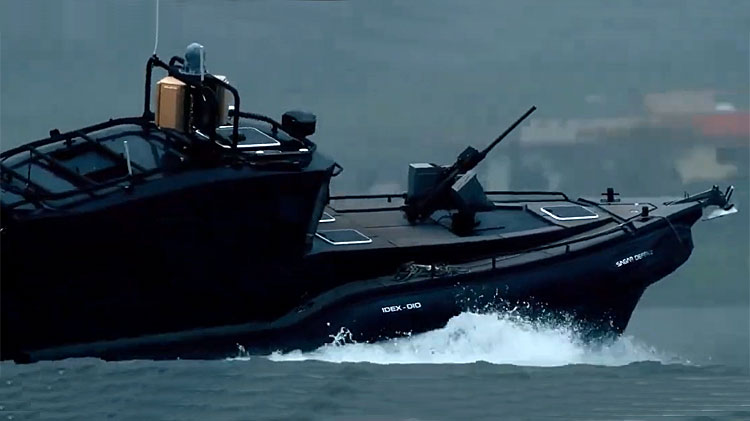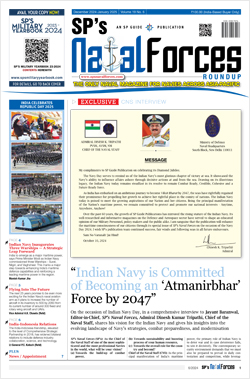INDIAN ARMED FORCES CHIEFS ON OUR RELENTLESS AND FOCUSED PUBLISHING EFFORTS

The insightful articles, inspiring narrations and analytical perspectives presented by the Editorial Team, establish an alluring connect with the reader. My compliments and best wishes to SP Guide Publications.

"Over the past 60 years, the growth of SP Guide Publications has mirrored the rising stature of Indian Navy. Its well-researched and informative magazines on Defence and Aerospace sector have served to shape an educated opinion of our military personnel, policy makers and the public alike. I wish SP's Publication team continued success, fair winds and following seas in all future endeavour!"

Since, its inception in 1964, SP Guide Publications has consistently demonstrated commitment to high-quality journalism in the aerospace and defence sectors, earning a well-deserved reputation as Asia's largest media house in this domain. I wish SP Guide Publications continued success in its pursuit of excellence.
- MoD initiates comprehensive review of Defence Acquisition Procedure 2020, pushes for defence reforms
- G7: The Swansong
- Kalinga Connect: South Asia to Polynesia
- Advanced MRSAM for India for a greater firepower
- Must Credit DRDO for Operation Sindoor, now what is next for defence R&D?
- Operation Sindoor | Day 2 DGMOs Briefing
- Operation Sindoor: Resolute yet Restrained
Autonomous Platforms in Sea Warfare
The Indian Navy has successfully tested indigenous autonomous weaponised boat swarms (AWBS) with plans to deploy these for maritime and inland water security
 |
The Author is Former Director General of Information Systems and A Special Forces Veteran, Indian Army |

According to news reports of October 28, 2024, the Indian Navy has successfully tested indigenous weaponised boat swarms (AWBS) developed by 'Sagar Defence Engineering' and has placed an order for 12 of these units; 10 designated for naval operations and two to be deployed in Pangong Tso. This distribution highlights the AWBS system adaptability for both maritime and inland water body security.
Sagar Defence Engineering is a Pune-based company, which has been instrumental in innovative technologies. The trials were conducted off the coast of Mumbai. The AWBS featuring an unmanned surface vessel is equipped with advanced surveillance and combat capabilities. Each boat is equipped with a dual camera, day and night radar, and a 127mm SRCG gun enabling it to identify and neutralise threats autonomously. Control is maintained through a remote station, enabling operators to oversee and direct action of the swarms.
India's AWBS development underscores its commitment to integrating unmanned systems into its Armed Forces, aligning with the nation's broader focus on indigenous defence manufacturing.
Adding to its versatility, the AWBS incorporates an unmanned aerial vehicle (UAV) for enhanced situational awareness and can be operated in conjunction with multiple boats from a single monitoring station, Navigation relies on a combination of GPS and India's own NAVIC system, ensuring operational reliability, even in a GPS-denied environment. Development of the AWBS is significant since it positions India among the few nations with advanced autonomous naval capabilities.
A comment on social media reads, "It is a very important arsenal. The Indian tech ecosystem is finally getting its place in the defence platforms. Such tech-enabled platforms will be a great boost to defence and the industrial strength of India. GoI should continue reducing the friction points for private companies to go to the market."
The Indian Navy is advancing its unmanned underwater capabilities with a ₹2,500 crore initiative to develop over 100-tonne unmanned underwater vehicles (UUVs) for tasks such as mine-laying, surveillance, and anti-submarine warfare.
The AWBS is expected to play a crucial role in enhancing maritime security and safeguarding the coastal borders. Further development and integration of the AWBS is expected to continue as the system proves its effectiveness in operational deployments. The system is a significant step in cutting-edge autonomous technology. It aligns with India's increasing focus on indigenous defence manufacturing and the integration of unmanned systems into its Armed Forces.

It was reported in these columns in September 2024 that the Indian Navy is preparing for future warfare by upgrading its unmanned underwater capabilities and building six next-generation diesel-electric attack submarines Project-76 (P-76). The Ministry of Defence (MoD) has approved a ₹2,500 crore plan to build 100-tonne unmanned underwater vessels (UUVs) to enhance the Navy's capabilities in underwater operations, including mine laying, surveillance, and launching weapons. A tender for this is to be issued subsequently.
The proposal is for UUVs weighing over 100 tonnes, which would be equipped with strike capabilities against enemy submarines and surface vessels, These UUVs would give the Indian Navy niche capabilities, enabling multiple operations. The Navy has plans to use such vessels for multiple tasks such as laying mines and mine clearing operations, surveillance, and launching weapons. The Navy is looking for UUVs with capability to remain underwater for very long hours at long distances from the shore to keep an eye on the movement of suspicious vessels and other activities and safeguard national interests. The Navy would be issuing a tender for the project under the Make-1 procedure in the next few months, enabling Indian shipyards to bid for the project under the Atmanirbhar initiative.
Geopolitical analysts highlight the growing significance of UUVs in modern warfare, with their scalability and affordability seen as essential for maintaining strategic advantages in contested regions like the Indo-Pacific.
Geopolitical analyst Brandon J. Weichert wrote in his recent article, titled 'The Navy's Nightmare Is Coming True: The Age of the Submarine Is Ending' that with the age of manned submarines and aircraft carriers fading, the US Navy must shift its focus toward UUVs like DARPA's prototype, the 'Manta', adding that UUVs offer a more affordable and scalable alternative to traditional nuclear submarines, which the US struggles to maintain in adequate numbers.
Drawing attention to the drone revolution witnessed in modern conflicts, he writes that undersea drones can complement and extend the Navy's reach, allowing the US. to meet emerging threats without risking significant loss. And, mass-producing and deploying UUVs could be crucial for American strategic success, especially in contested regions like the Indo-Pacific.
While manned submarines and aircraft carriers are unlikely to become obsolete soon, the integration of AI-driven UUVs and AWBS will complement existing systems, providing flexibility and enhancing operational reach.
Interestingly, Weichert points out that the US already "cannot" meet the increased demand that the dynamic global threat environment is placing upon their shipyards for new and better submarines, and America's enemies are catching up with the US in terms of quantity and quality of their submarines. "In today's contested global environment, notably in the Indo-Pacific, UUVs could be a key difference for the US Navy between victory and defeat", according to him.
Finally, there is much merit in what Weichert says although aircraft carriers and submarines are not likely to become extinct anytime in the near future although in a 2005 wargame, the USS 'Ronald Regan', a $6 billion aircraft carrier, was sunk by the Swedish submarine HMS 'Gotland', a $100 million diesel-powered vessel. Looking at the development in the use of artificial intelligence (dangers included) and increasing possibilities of enemy interference/manipulation of AI-driven platforms, sole reliance on autonomous systems would also not be advisable. Therefore, manned and unmanned autonomous platforms would continue to be developed simultaneously. But yes, India certainly needs to enhance its underwater capabilities, to include a large number of UUVs, which can also be used in swarms.





